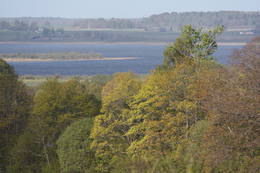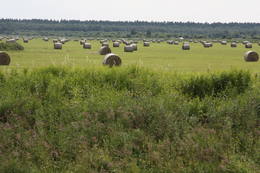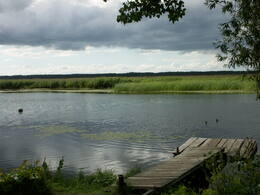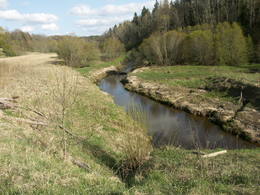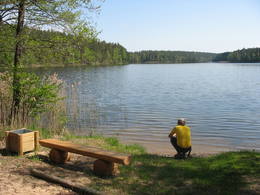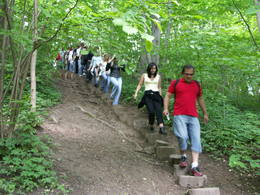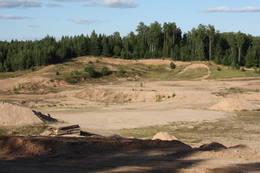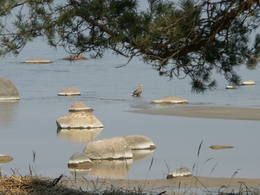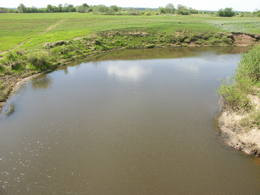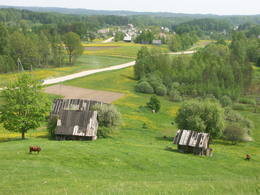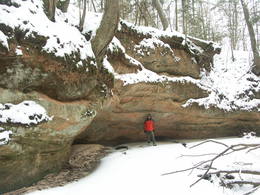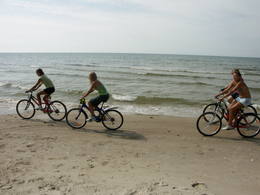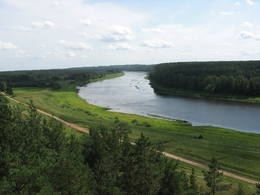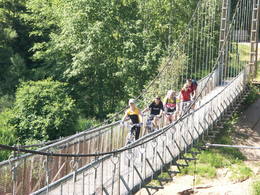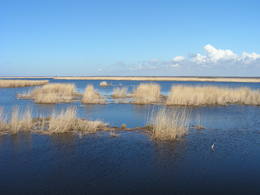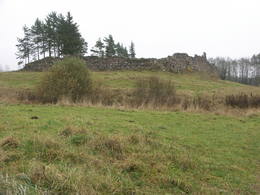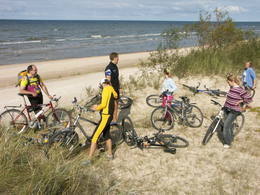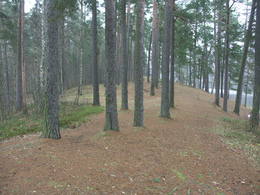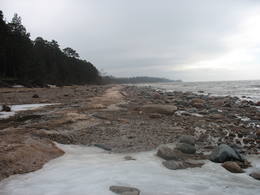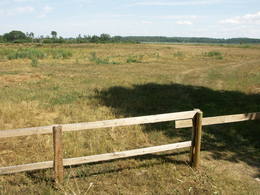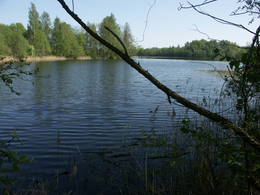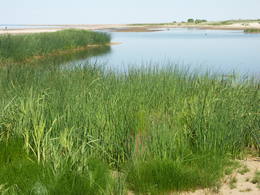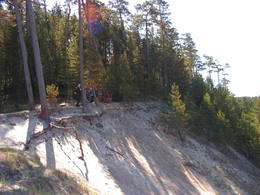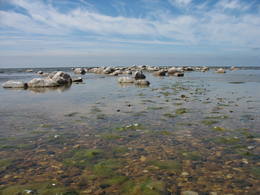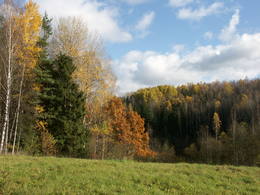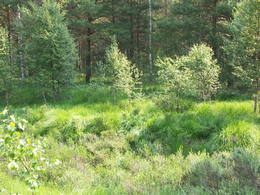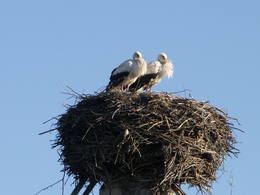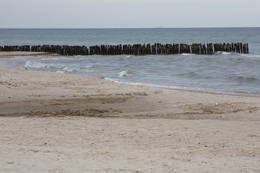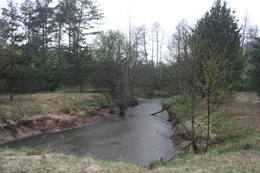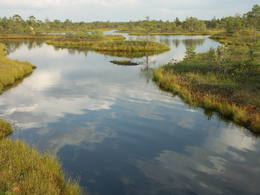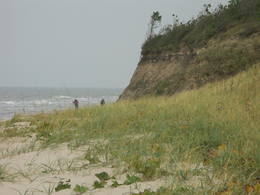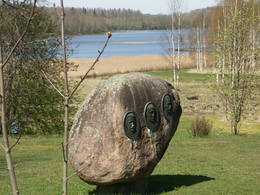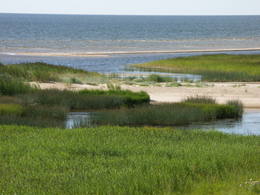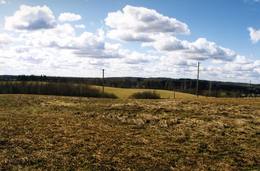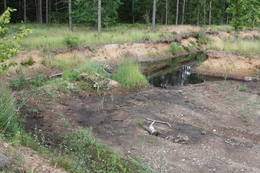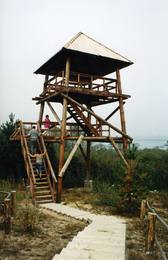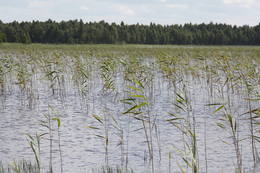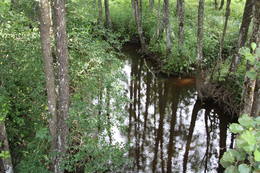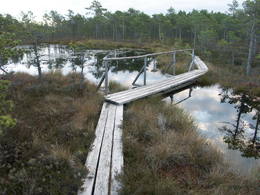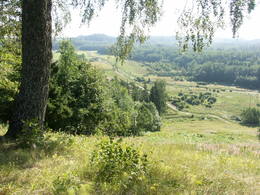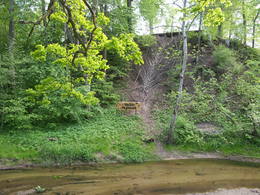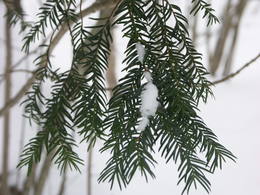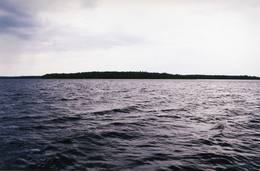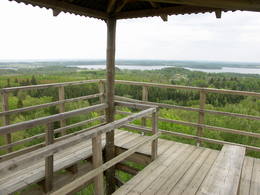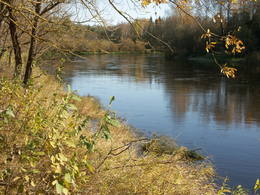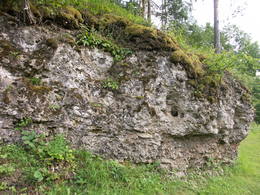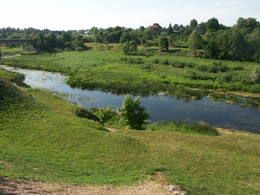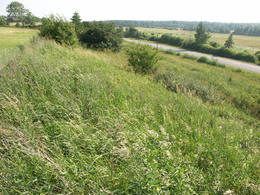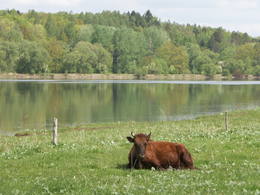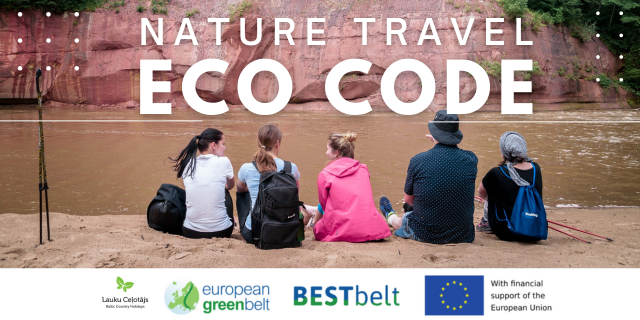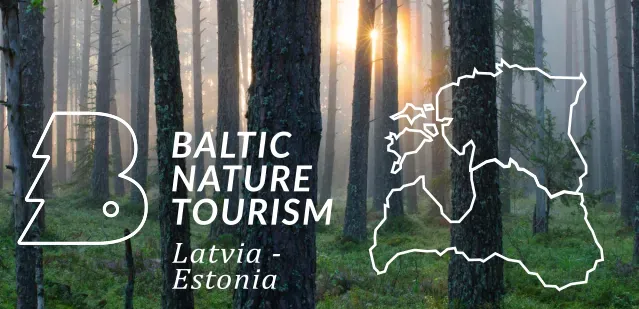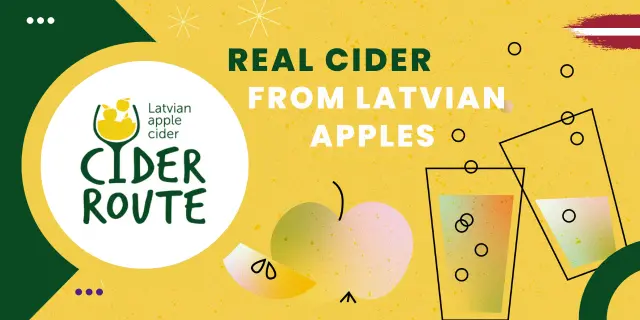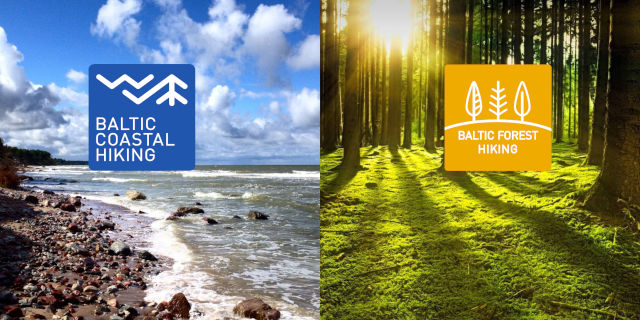Citas dabas teritorijas
Dabas teritorijas
| Pārskats | Detaļas |
|---|---|
|
Latvija
Piejūras dabas parks~40 km garš Rīgas jūras līča piekrastes posms ar trīs lielu upju – Lielupes, Daugavas un Gaujas grīvām, aprimušu kāpu veidojumiem un biotopiem, jūrmalas pļavām un mežainām jūrmalas kāpām, kas ir nozīmīgs rekreatīvais resurss. |
|
|
Latvija
Durbes ezera pļavasDabas liegums ietver ezera austrumdaļu ar Lāņupes ietekas rajonu un ezera ZA un DA daļai pieguļošās krastu teritorijas. Tas veidots ezera apkārtnē esošo palieņu pļavu un putnu aizsardzībai. Lai apskatītu dabas liegumu, nav jādodas tā teritorijā! To var lieliski izdarīt piestājot Vecpils – Rāvas – Aisteres ceļa malā, no kura paveras plaša ainava uz ezeru ar Grobiņas vēja ģeneratoru parka baltajiem rotoriem fonā. Ezera krasta nogāzes, kas neatrodas dabas lieguma teritorijā ir vieta, no kuras vislabāk pārskatāma teritorija potenciālajiem putnu vērotājiem. Dienvidos no lieguma atrodas Durbe – pēc iedzīvotāju skaita Latvijas mazākā pilsēta. |
|
|
Latvija
Užavas lejteceAinaviski atklāta teritorija plašu lauksaimniecībā izmantojamo zemju masīva vidū abpus Užavas upei kādus desmit kilometrus pirms tās ietekas Baltijas jūrā. Teritorija uz visām pusēm lieliski ir saskatāma no Vendzavas – Ziru ceļa, kas to šķērso dabas parka ziemeļdaļā. No šī ceļa var nodoties arī putnu vērošanai (galvenais iemesls dabas parka izveidei – migrējošo putnu un griežu aizsardzība), kas Užavas pļavās koncentrējas pavasara un rudens migrāciju laikā. Citādā ziņā teritorija nav labiekārtota.
|
|
|
Latvija
TērveteTērvetes dabas parks atrodas Zemgales ainavai nepierastā un neraksturīgā – izteiktajā Tērvetes upes ielejā un tās skaistajos krastos, kurus ieskauj plašs mežu masīvs, kas veiksmīgi pielāgots apmeklētāju atpūtai, apvienojot gan dabas vērtumus, gan šejienes kultūrvēsturisko mantojumu. Tērvetes dabas parks ir viens no Zemgales populārākajiem tūrisma objektiem, un apmeklētājus piesaista ar Veco priežu parku, dižsilu, Sprīdīšu dendrāriju, pilskalniem (Tērvetes, Klosterkalns, Svētkalns), A. Brigaderes memoriālo muzeju „Sprīdīši”, daudzveidīgajiem pasaku tēliem, bērnu atrakcijām, ainavām, blīvo taku tīklu u.c. Dabas parks 2004. g. tika nominēts kā ģimenei draudzīgākā vieta. Šobrīd parkā izveidots un kursē "Pasaku vilcieniņš". |
|
|
Latvija
VecdaugavaPlašs jūrmalas pļavu, vecupju un niedrāju komplekss, kas veidojies kādreizējās Daugavas gultnes vietā starp Vecmīlgrāvi un Vecāķiem. Teritorijā sastopamas arī iekšzemes kāpu pļavas ar kāpsmildzeni (rets biotops). Vecdaugava ir nozīmīga teritorija kā putnu ligzdošanas, tā arī atsevišķu retu augu sugu dzīves vieta. Vecdaugavas pussalas dienvidu daļā – Skanstniekos (te viduslaiku nocietinājumu paliekas – Zviedru skanstis) atrodas Vecdaugavas novadpētniecības un zvejniecības muzejs.
|
|
|
Latvija
Ziemeļgaujas aizsargājamo ainavu apvidusIzstiepta teritorija no Valmieras līdz Apes novadam, kuras galvenā "ass" ir neregulētās Gaujas ieleja ar blīvu vecupju sistēmu, ozolu parkveida pļavām to krastos, ozolu un platlapju audzēm. Daudzu retu un aizsargājamu putnu, īpaši griežu, dzeņu, medņu u.c. sugu dzīves un vairošanās vieta. Viena no nozīmīgākajām lapkoku praulgrauža dzīves vietām.
|
|
|
Latvija
RiežupeRiežupes dabas parks veidots g.k. Riežupes izteksmīgās ielejas, tai raksturīgo dabas vērtību – nogāžu un gravu mežu, dažādu ģeoloģisku dabas pieminekļu - smilšakmens atsegumu, alu, ūdenkritumu, upes straujteču posmu, dažādu sugu, mežu masīvu un ainavas aizsardzībai. Parka atrodas viens no Kurzemes populārākajiem tūrisma objektiem – Riežupes alas - garākais mākslīgo alu labirints Latvijā, kura eju kopgarums ir 460 m. Sākotnēji dabas veidotās alas 19. gs. vidū mākslīgi paplašināja baltās smilts ieguves nolūkos, kuras izmantoja stikla ražošanai. Parkā izveidots velotūrisma maršruts. |
|
|
Latvija
Ziemeļvidzemes biosfēras rezervātsLatvijas lielākajā īpaši aizsargājamā dabas teritorijā (ap 6 % no valsts teritorijas), kas aptver daļu no Limbažu, Valmieras un Valkas rajoniem, sastopams ļoti daudzveidīgs un atšķirīgs ainavu, biotopu un sugu kopums. Salaca (ietilpst Salacas ielejas dabas parkā) ir viena no Baltijas jūras reģiona nozīmīgākajām lašu nārstu vietām. Upes ielejas ainava ar smilšakmens atsegumiem piesaista daudzus apmeklētājus – ne velti tā ir otra populārākā Vidzemes ūdenstūristu upe. Rīgas jūras līča austrumu piekraste salīdzinoši īsā krasta posmā izceļas ar lielu ainavu un biotopu atšķirību. Tās ziemeļos plešas piejūras Randu pļavas, vidusdaļā – smilšaini liedagi, bet dienviddaļā – akmeņaina krastmala divu desmitu kilometru garumā. Igaunijas pierobežā ir izvietojušies t.s. Ziemeļu purvi (ZBR dabas lieguma zona, NATURA 2000 teritorija "Ziemeļu purvi"), bet Sedas tīrelis ir viena no nozīmīgākajām putnu atpūtas un barošanās vietām migrāciju laikā. Rezervāta teritorija izceļas ar lielu mežu daudzveidību un tajā sastopami visi Latvijā esošie mežu tipi. Apmeklētājiem izveidotas interesantas dabas takas ar skatu torņiem vai platformām Randu pļavās, Burtnieka ezera krastā, Planču purvā, Niedrāju - Pilkas purvā, Dziļezera un Lielezera krastos u.c. Mazsalacas Skaņākalna parks ir viens no populārākajiem Ziemeļvidzemes tūrisma objektiem. Teritorijā atrodas arī daudzi nozīmīgi kultūras pieminekļi, t.sk. viena no pirmajām Latvijas apdzīvotām vietām, kur šodien atrodas t.s. Zvejnieku kapulauks (5. – 2. g.t. pr. Kr.). ZBR atrodas vēl divas dabas lieguma zonas - NATURA 2000 teritorijas "Vidusburtnieks" un "Augstroze".
|
|
|
Latvija
Rāznas nacionālais parksLatvijas jaunākais nacionālais parks (2007. g.) atrodas „Zilajā ezeru zemē” – Latgales novadā. Parka viens no izveides mērķiem ir Latvijas ūdeņiem bagātākā – Rāznas ezera, salām bagātākā – Ežezera un citu ūdeņu, Latgales augstienei raksturīgās pauguraiņu ainavas un kultūrvides saglabāšana. Šobrīd viens no populārākajiem nacionālā parka objektiem ir Mākoņkalns ar skaisto skatu uz Rāznas ezeru. Jaunizveidotajā parkā šobrīd tikai tiek plānota un veidota ar tūrismu saistīto labiekārtojumu – taku, maršrutu u.c. izveide, tādēļ būtu vēlams apmeklēt g.k. šobrīd jau labiekārtotos objektus.
|
|
|
Latvija
Papes dabas parksNozīmīgākās vērtības ir seklais lagūnas tipa ezers – Papes ezers ar palieņu pļavām, Baltijas jūras piekraste, Nidas purvs un bagātīgā putnu valsts (konstatētas > 270 putnu sugas). Starp Papes ezeru un Baltijas jūru atrodas Latvijā vecākā (no 1966. g.) putnu gredzenošanas stacija, kurā ķer un gredzeno putnus un sikspārņus. Papes ezera apkārtne ir pirmā vieta Latvijā, kur ezera palieņu pļavu apsaimniekošanas nolūkā izlaida t.s. „savvaļas” zirgus („Konik” šķirne).
|
|
|
Latvija
AugšdaugavaApvidus veidots neregulētās Daugavas augšteces ielejas, dabas un kultūrainavas un bioloģiskās daudzveidības aizsardzībai. Parka teritorijā ir izveidotas dabas takas, velomaršruti, bet Daugava ir piemērota braucieniem ar laivām. Teritorijā ietilpst Daugavas loku dabas parks (sk. sadaļu „Dabas parki”). |
|
|
Latvija
Pilskalnes SiguldiņaVieta, kur var nodoties īsākām un garākām pastaigām. Te izveidota 1,6 km garā Sprīdīša taka (ar Annas Brigaderes pasaku varoņu koka skulptūrām), 3,8 km garā Meža ainavu mācību taka un 8 km (vienā virzienā) garā Augšzemes ainavu taka. Takas atrodas ledāja veidotā subglaciālā iegultnē, kur viens aiz otra izvietojušies vairāki ar caurtekām savienoti ezeriņi un purvi. Ainavas un citu vērtību aizsardzības nolūkā izveidots dabas liegums. Taku sākumā (netālu no Pilskalnes) ir apskatāms ap 30 m augstais Melnaiskalns (Rāmavas pilskalns).
|
|
|
Latvija
MežoleVidzemes augstienes ziemeļdaļas – Mežoles pauguraines daļa, kas ir nozīmīga boreālo (ziemeļu) un purvaino mežu, kā arī dažāda tipa purvu izplatības vieta un aizsargājamu bezmugurkaulnieku sugu dzīves vieta.
|
|
|
Latvija
Pavasaru - Odiņu polderisAtklāta teritorija 3,5 km garumā un 2 km platumā, kas atrodas Lielupes kreisajā krastā starp Pavasaru ciemu un Odiņu mājām. Polderis veidots padomju laikā ar mērķi iegūt lauksaimniecībā izmantojamās zemes un tolaik arī intensīvi izmantots. Mūsdienās tas pamazām aizaug. Neskatoties uz to, šeit ir Eiropā novērotais lielākais griežu blīvums. Ziemeļu – dienvidu virzienā polderi šķērso grantēts ceļš, kas ir piemērota vieta griežu klausīšanai. |
|
|
Latvija
Rīgas jūras līča rietumu piekraste„Rīgas jūras līča rietumu piekraste” - nozīmīga patvēruma un barošanās vieta lielam skaitam migrējošo putnu sugu visa gada garumā. Biežāk sastopamās aizsargājamās putnu sugas – brūnkakla un melnkakla gārgale, jūrmalas dižpīle, kākaulis, tumšā pīle un mazais ķīris, teritorija ir nozīmīga arī rifu aizsardzībai. Teritorija atrodas iepretim Dundagas, Rojas un Engures novadam, kā arī Jūrmalas pilsētai, tās platība ir 132 173 ha. Teritorija ietver dabas parka „Engure” un Ķemeru nacionālā parka jūras daļu.
|
|
|
Latvija
Kristus Karaļa kalnsAtrodas nepilnus 2 km austrumos no Aglonas, Aglonas – Dagdas ceļa malā. Tā ieceres autors ir Ēriks Delpers, kurš 2006. g. uzsāka vietas labiekārtošanu, izveidojot brīvdabas skulptūru dārzu un stādījumus. Kristus Karaļa kalns šobrīd atrodas izveides procesā, taču neskatoties uz to – objekts, ko ir vērts redzēt! |
|
|
Latvija
Dvietes palieneUnikāla dabas teritorija – Dvietes senleja ar Skuķu un Dvietes ezeriem un senlejai pieguļošajām palieņu pļavām, kas plūdu laikā darbojas kā sava veida Daugavas ūdeņu „uzkrājējs” jeb ventilis. Tā ātri uzņem lielas palu ūdeņu masas, bet vēlāk tās lēnām atdod. Senlejas ūdens līmeņa svārstību īpatnības ir iemesls savdabīgajai senlejas ekosistēmai, kas ir nozīmīga augu un putnu dzīves vieta gan migrāciju, gan ligzdošanas laikā. Skatīt arī Dvietes palu zinas |
|
|
Latvija
Abavas senlejas dabas parksAbavas senlejas posms no Kandavas līdz tās ietekai Ventā ir ainaviskā un reljefa ziņā izteiksmīgākais upes ielejas posms Kurzemes novadā. Abavas ielejas dziļums sasniedz 30 – 40 m, platums – līdz pat 300 un vairāk metriem. Teritorija izceļas ne tikai ar lielu bioloģisko (> 800 augu sugu) un biotopu daudzveidību, dabas pieminekļiem – avotiem, ūdenkritumiem, iežu atsegumiem, dižakmeņiem, bet arī ar daudzajiem kultūrasvēstures pieminekļiem – pilskalniem, baznīcām, senkapiem, kultūrainavu, kā arī mazpilsētām – Kandavu un Sabili, kuru centri ir pilsētbūvniecības pieminekļi. Sabiles Vīnakalns un Pedvāles mākslas brīvdabas muzejs ir ļoti populāri tūrisma objekti. Kultūras vērtību aizsardzības nolūkos izveidota kultūrvēsturiskā teritorija „Abavas ieleja”. Lai „uzturētu” ielejas ainavu, Drubazās un Tēvkalnos „saimnieko” dzīvei savvaļā pielāgotie mājlopi. Tūristiem izveidotas dabas takas, bet Abava ir populārākā Kurzemes ūdenstūristu upe. Diemžēl, neskatoties uz ārkārtīgi lielo tūrisma un resursu potenciālu Latvijas mērogā, tie šobrīd ir nepietiekami minimāli izmantoti. |
|
|
Latvija
Jūrmalas parks LiepājāViens no lielākajiem cilvēka veidotajiem Latvijasparkiem (70 ha), kas izstiepies no Liepājas ostas līdz Dienvidu fortam > 3 km garumā. Tā izveidi uzsāka jau 1870. g. pēc pilsētas mēra K. Ūliha iniciatīvas, uzbūvējot kūrmāju un strūklaku. 19. - 20. gs. mijā ap Dzintaru un Liepu ielām parādījās greznu villu un savrupmāju apbūve. Viena no skaistākajām ir jūgendstilā celtā savrupmāja Liepu ielā 27, kurā atrodas Krievijas ģenerālkonsultāts. Ēkai ir slēgta uzeja, balkoni, pildrežģa konstrukcijas un kārniņu jumts (arhitekti G. Jenike un P. M. Berči). Jūrmalas parks visās sezonās ir iecienīta pastaigu un dažādu aktivitāšu norises vieta. Te meklējams stadions „Daugava”, tenisa korti, koncertestrāde “Pūt, vējiņi!”, vasaras kafejnīcas, minigolfa laukums, bērnu rotaļu laukums, skeitparks. Šeit meklējamas lielākās Latvijas bungas – vides dizaina objekts. |
|
|
Latvija
Korneti-PeļļiViena no Latvijas izteiktākajām subglaciālo iegultņu sistēmām, kurā izvietojušies 11 dažāda lieluma un dziļuma ezeri. Izcili ainaviska teritorija, kurā īpaši tāli un skaisti skati līdz pat Hānjas augstienei Dienvidigaunijā paveras no Drusku – senču pilskalna. Teritorija veidota arī biotopu, piemēram, boreālo un nogāžu mežu aizsardzībai. Lai arī teritorijai piemīt ārkārtīgi liels ainaviskais un tūrisma potenciāls, tas līdz šim ir minimāli izmantots. Dabas liegums atrodas Veclaicenes aizsargājamo ainavu apvidū (sk. sadaļu "Aizsargājamo ainavu apvidi").
|
|
|
Latvija
Kaļķupes ielejaKaļķupes ieleja veidojusies, Pilsupei (veidojas satekot Kaļķupei un Mazupei) šķērsojot Šlīteres Zilo kalnu turpinājumu dienvidos no Vīdales un Kaļķiem. Tā rezultātā izveidojusies izteikta upes ieleja ar ļoti sazarotu gravu un sānu gravu tīklu, kur vietām redzami Devona perioda smilšakmens atsegumi. Viena no teritorijas izteiksmīgākajām reljefa formām ir Puiškalns (Kaļķupes un Mazupes satekas vietā) – pilskalns un sena svētvieta, kas pazīstams kā iecienīts Talsu rajona tūrisma objekts. Nogāžu meži, dažādi pļavu tipi un bagātīgais augu sugu klāsts ir vēl viena šejienes dabas vērtība. Dabas lieguma teritorija ietver arī no Pilsupes ziemeļos esošo Šlīteres Zilo kalnu nogāzi, Lorumupes gravu sistēmu u.c. gravas.
|
|
|
Latvija
Nida - PērkoneAizsargājamā jūras teritorija „Nida - Pērkone” ir viena no bioloģiski daudzveidīgākajām un dabas aizsardzībai nozīmīgākajām jūras teritorijām Baltijas jūras atklātās daļas piekrastē – šeit atrodamas izcilākās rifu teritorijas. Migrācijas laikā teritoriju šķērso vairums Latvijā sastopamo migrējošo putnu sugu. Teritorija īpaši nozīmīga lielās gauras un mazā ķīra aizsardzībai. Tā atrodas iepretim Rucavas un Nīcas novadam, platība - 36 703 ha. Teritorija daļēji pārklājas ar dabas parka „Pape” jūras daļu un ietver dabas parka „Bernāti” jūras daļu.
|
|
|
Latvija
Daugavas lokiDabas resursu, dabas, ainavas, bioloģiskās daudzveidības un kultūras pieminekļu ziņā – viens no bagātākajiem un ainaviski neparastākajiem Latvijas dabas parkiem, kura galvenā „vērtība” ir mazskartā Daugavas vidusteces ieleja ar astoņiem lieliem lokiem (garums 4 – 8 km) un tās pieteku gravām. Izcilas ainavas paveras no Daugavas ielejas stāvajiem krastiem, īpaši Slutišku un Ververu kraujām un Elernes grants kalna, kā arī citām vietām. Ielejas krastos atrodas divi desmiti dažādu arheoloģijas pieminekļu, senie senču pilskalni - Naujenes, Markovas, Vecračinas u.c., neskaitāmi dievnami - Juzefovas, Spruktu, Borovkas, Elernes, Sīķeles, Kaplavas u.c., muižas (Rozališku, Lielbornes u.c.), kā arī unikālā vecticībnieku apdzīvotā Slutišku sādža, kurā apmeklētājiem izveidota muzeja ekspozīcija. Parka teritorijā atrodas arī interesantas dabas takas, velomaršruti, var veikt pārgājienus ar zirgiem. Nesen Krāslavā uzcelts jauns un moderns skatu tornis. Saistošs ir nobrauciens pa Daugavu ar laivām. Dabas parks ietilpst lielākā īpaši aizsargājamā dabas teritorijā - Augšdaugavas aizsargājamo ainavu apvidū. |
|
|
Latvija
Gaujas nacionālais parksPirmais Latvijas nacionālais parks (dibināts 1973. g., otrais vecākais Baltijā) ar senām dabas aizsardzības un tūrisma tradīcijām, kā arī viens no Latvijas populārākajiem tūrisma galamērķiem. Parka „galvenā artērija” ir Eiropas mērogā nozīmīgā ledāja kūstošo ūdeņu veidotā Gaujas senleja (95 km garš senlejas posms) ar daudzo sānu pieteku dziļajām gravām, kuru krastos paceļas Baltijas skaistākie un iespaidīgākie Devona perioda smilšakmens atsegumi. Pie Siguldas Gaujas senleja sasniedz maksimālo dziļumu – 85 m. Teritorija izceļas ar lielu sugu daudzveidību (ap 900 augu sugu). Gauja ir arī Latvijas populārākā ūdenstūristu upe, kuras krastos ir izveidotas tipveida tūristu apmetnes. Infrastruktūras, t.sk. dabas taku un tūrisma maršrutu ziņā Gaujas nacionālais parks ir viena no vislabāk labiekārtotākajām Latvijas īpaši aizsargājamām dabas un NATURA 2000 teritorijām. Līgatnes dabas takas ar savvaļas dzīvnieku voljēriem ir lielākais un bagātākais šāda mēroga objekts Baltijā. Gaujas nacionālā parka teritorijā atrodas arī populāri Baltijas mēroga kultūras pieminekļi – Turaidas muzejrezervāts, Cēsu viduslaiku vecpilsēta ar pils kompleksu un Sv. Jāņa baznīcu, Āraišu ezerpils u.c. Parka apmeklētāju centri atrodas Siguldā, Līgatnes dabas takās un pie Zvārtes ieža. Šobrīd Gaujas nacionālā parka administrācija Siguldā veido jaunu un modernu apmeklētāju centru, kura izveidi plāno pabeigt 2008. g. pirmajā pusē. |
|
|
Latvija
PapeSeklais lagūnas tipa ezers ar pieguļošajām teritorijām ir starptautiskas nozīmes mitrājs, kura apkārtnē konstatēta 271 putnu suga. No tām 43 ir ierakstītas Latvijas Sarkanajā grāmatā, bet 15 – Eiropas Sarkanajā grāmatā. Dabas parkā ietilpst arī Nidas purvs un parkam pieguļošā jūras teritorija, kas ietilpst jaunizveidotajā aizsargājamā jūras teritorijā „Nida – Pērkone”. Starp Papes ezeru un Baltijas jūru atrodas Latvijā vecākā (no 1966. g.) putnu gredzenošanas stacija, kurā tiek ķerti un gredzenoti arī sikspārņi. Papes ezera apkārtne ir pirmā teritorija Latvijā, kur ezera palieņu pļavu apsaimniekošanas nolūkā tika izlaisti dzīvei savvaļā pielāgotie mājlopi – sākumā – zirgi („Konik” šķirne), vēlāk – taurgovis un sumbri. Apmeklētājiem pieejami putnu un dabas vērošanas torņi, dabas takas u.c. Papes Ķoņu ciems ir savdabīgs piekrastes zvejniekciema piemērs. Pape ir populāra putnu vērošanas vieta. Dabas parka apmeklētāju centrs atrodas Pasaules dabas fonda „Dabas mājā”. |
|
|
Latvija
VecpiebalgaVeidots Vidzemes augstienes centrālās daļas kultūrainavas un ezeraiņu ainavas ar Alaukstu, Inesi, Taunu u.c. ezeriem, kā arī sugu un biotopu aizsardzībai. Vecpiebalgā atrodas daudzi nozīmīgi kultūras tūrisma objekti – Vecpiebalgas luterāņu baznīca, Vecpiebalgas pilsdrupas, Vecpiebalgas muiža un vairāku nozīmīgu Latvijas kultūras darbinieku dzīves un darba vietas, kurās izveidoti memoriāli muzeji. Ezeri piesaista makšķerniekus, bet ap Alaukstu ziemā tiek organizētas tradicionālās distanču slēpošanas sacensības. Ineša salās un pussalā izveidots Sproģu dabas liegums.
|
|
|
Latvija
Slīteres nacionālais parksSlīteres nacionālo parku (dibināts 2000. g.) pamatoti dēvē par Baltijas jūras iepriekšējo attīstības stadiju „brīvdabas muzeju”. Šo ģeoloģisko notikumu mūsdienu „dzīvi” liecinieki ir Šlīteres Zilie kalni – stāvā, līdz 20 – 30 m augstā Baltijas ledus ezera senkrasta kāple (Baltijas jūras stadija pirms 10 000 gadu), Stiebru kalni – Ancilus ezera senkrasts (pirms 8 – 9 tūkstošiem gadu ), bet Eiropā lielākā – kangaru (kāpu vaļņi) un vigu (mitras starpkāpu ieplakas) ainava ir Litorīnas jūras laika veidojums (pirms 4 – 7 tūkstošiem gadu). Maigais Ziemeļkurzemes klimats ir iemesls daudzu Latvijā retu augu (liela daudzveidība, ap 860 augu sugu, t.sk. reti sastopamā parastā īve un Baltijas efeja) sastopamībai. Sava veida „nopelns” šejienes dabas vērtību saglabāšanā ir bijis arī jūras piekrastē kādreiz pastāvošajam padomju militāram režīmam, kura dēļ tā pusgadsimta garumā saglabājās apmeklētāju un būvniecības ziņā mazskarta. Tā laika liecinieki ir pamestās PSRS armijas bāzes un dažādi militārie objekti. Slīteres nacionālā parkā atrodas viens no populārākajiem Latvijas tūrisma objektiem – Kolkas rags, kuru gada laikā apmeklē vairāk nekā 50 000 ceļotāju, bet putnu pavasara migrāciju laikā stundas laikā pār to pārlaižas desmitiem tūkstoši putnu. Baltijas jūras krasta posmā – t.s. „Lībiešu krastā” no Kolkas līdz Sīkragam un Ovīšiem ir saglabājušies pasaulē mazākās minoritātes – lībiešu zvejniekciemi un citi to kultūras liecinieki. Tūristu vajadzībām izveidotas četras dabas takas, velomaršruti, skatu tornis, apmeklējama Šlīteres bāka u.c. Nacionālā parka administrācija regulāri organizē vides izglītības pasākumus, ka pieejami ikvienam interesentam.
|
|
|
Latvija
BeberbeķiDabas parks veidots g.k. Rīgas „zaļās zonas” aizsardzībai. Tā lielāko daļu aizņem ar priežu silu un mētrāju apaugušas kāpas, bet tā dienviddaļā atrodas Beberbeķu ezers. Ezera apkārtnē ir labiekārtota. |
|
|
Latvija
AugšzemeTeritorijas izveides mērķis ir Augšzemes augstienes lielpauguru, ezeru – Sventes (ļoti dzidrs ūdens), Medumu, Ilgas u.c. ezeru, to salu, ainavas un sugu aizsardzība. Teritorijā ietilpst Sventes un Medumu ezeraines dabas parki un vairāki dabas liegumi – Bardinska ezers, Skujines ezers, Medumu ezera salas un Sventes ezera salas. Egļukalnā ir izveidots skatu tornis un kalnu slēpošanas trases. Neparasti skaistais apvidus ir piemērots pārgājienu veikšanai un, ja tajā būtu labākas kvalitātes ceļi, arī velobraucieniem, īpaši Sventes un Medumu ezeru apkārtnē. |
|
|
Latvija
Paradīzes (Gleznotāju) kalnsĻoti ainaviska vieta Siguldā, kas gleznota (no tā arī vēlāks nosaukums) un fotografēta kopš seniem laikiem! Paradīzes kalns būtībā nav kalns, bet gan vieta, kur Gaujas senlejas kreisā pamatkrasta nogāzi „pāršķeļ" varenā Vējupītes grava. No Paradīzes kalna paveras izcils skats uz Turaidas pili un Gaujas senleju, kur izveidota atpūtas vieta un skatu laukums. Līdz Paradīzes kalnam var nokļūt ar elektromobili. |
|
|
Latvija
Selga uz rietumiem no Tūjas„Selga uz rietumiem no Tūjas” – nozīmīga teritorija mazā ķīra aizsardzībai pavasara migrācijas laikā. Teritorija atrodas iepretim Salacgrīvas, Limbažu, Saulkrastu un Carnikavas novadam, tās platība ir 58 600 ha.
|
|
|
Latvija
Burtnieku ezera pļavu dabas liegumsPeriodiski aplūstošas palieņu pļavas Burtnieku ezera austrumu un dienvidu krastā, kas ir nozīmīga griezes u.c. retu putnu sugu ligzdošanas vieta. Pļavu apskates nolūkos, Vīsragā (pie Burtniekiem) ir izveidota dabas izziņas taka ar norādēm, informatīviem stendiem un skatu torni.
|
|
|
Latvija
Cārmaņa ezersDabas parks, kura lielāko daļu aizņem neprastās formas un līčiem bagātais Cārmaņa (arī Cārmins) ezers. Ezera ūdens ir ļoti tīrs, tādēļ tajā sastopamas Latvijai retas augu sabiedrības. Tā kā parka teritorijā nav tūristiem veidota infrastruktūra, interesenti var baudīt skatus, kas paveras uz ezera un tā apkārtni no Aulejas – Grāveru ceļa.
|
|
|
Latvija
Randu pļavu dabas liegumsAr niedrēm un meldriem klāts piejūras pļavu, lagūnu, dūņainu ezeriņu un smilšainu sēkļu mozaīkas izraibināts Rīgas līča austrumu krasta posms starp Ainažiem un Kuivižiem – Randu pļavas ("rand" - no igauņu valodas - krasts), kas ir ļoti nozīmīga ūdensputnu atpūtas un retu augu sugu (kopumā konstatētas ap 500 augu sugas) dzīves vieta. Pļavu iepazīšanai izveidots jauns putnu vērošanas tornis un dabas taka.
|
|
|
Latvija
Bernātu dabas parksDabas parks aptver Baltijas jūras piekrastes un jaunizveidotās aizsargājamās jūras teritorijas “Nida – Pērkone” daļu ar savulaik kustīgām, bet mūsdienās apstādinātām un aprimušām smilšu kāpām, kas tiek uzskatītas par augstākajiem Latvijas piekrastes kāpu veidojumiem. Šejienes vērtības ir arī Baltijas jūras krasta ainavas, smilšainās pludmales un nelielie zvejniekciemi. Dabas parka apskates nolūkos – Pūsēnu kalnā (viena no augstākajām Latvijas kāpām) izveidota dabas taka.
|
|
|
Latvija
Vitrupe-Tūja„Vitrupe - Tūja” - nozīmīga teritorija rifu aizsardzībai. Teritorija atrodas iepretim Salacgrīvas novadam, tās platība ir 3577 ha. Teritorija ietver dabas lieguma „Vidzemes akmeņainā jūrmala” jūras daļu.
|
|
|
Latvija
Krustkalni Nature ReserveKrustkalnu dabas rezervāta (dibināts 1977. g.) teritorijas augu sugu daudzveidību nosaka gan reljefa īpatnības – Madonas trepes valnis, pauguri, to nogāzes, starppauguru ieplakas ar purviem un ezeriņiem, gan arī šejienes biotopi – dabiskas pļavas, mežu lauces, avoksnāji un plašais mežu masīvs ar vecām koku audzēm. Rezervāta teritorijā konstatētas > 800 augu sugu. Rezervāta apmeklējums (Krāku avoti, Svētes – Dreimaņu ezers, jaunais apmeklētāju centrs "Dreimaņos" u.c.) iespējams tikai un vienīgi Teiču dabas rezervāta administrācijas gidu/reindžeru pavadībā, savlaicīgi piesakoties un noteiktos laikos! |
|
|
Latvija
Grīņu dabas rezervātsLatvijai neparastais meža tips – grīnis (ir divi grīņu tipi – viršu un zāļu grīnis), kas radies ilgstošā dabas un cilvēka mijiedarbības rezultātā, sastopams tikai dažviet Latvijas Baltijas jūras piekrastē un šeit augošā retā augu suga – grīņu sārtene (u.c. retas sugas) bija galvenie iemesli, kādēļ 1936. g. tika izveidots Grīņu dabas rezervāts. Rezervātu ziemeļu – dienvidu virzienā šķērso bijušā Ventspils – Liepājas dzelzceļa līnija. Rezervāta apmeklējums ir aizliegts! |
|
|
Latvija
EmbūteAinaviska teritorija Embūtes pauguraines daļā, kas veidota Embūtes ainavas, biotopu un sugu aizsardzībai. Embūtes senlejas ekotūrisma taka un Embūtes dabas parka meža taka (tikai gida pavadībā) iepazīstina ar ledāja veidoto Embūtes pauguraini, gravām (gravas un nogāžu meži – aizsargājami biotopi) un nozīmīgiem dabas un kultūras pieminekļiem – Embūtes pilskalnu, muižas, pils un baznīcas drupām, Kuršu virsaiša Induļa nāves vietu, Joda dambi, pļavām, skatu torni u.c. Apkārtnē izveidoti šobrīd nemarķēti velomaršruti. |
|
|
Latvija
Irbes šaurums"Irbes šaurums” – īpaši nozīmīga teritorija putnu migrācijas laikā - biežāk sastopamās aizsargājamās putnu sugas – tumšā pīle, melnā pīle, kākaulis, mazais ķīris, brūnkakla un melnkakla gārgales, kā arī melnais alks. Teritorija atrodas iepretim Dundagas novadam un Ventspils novadam, tās platība ir 172 412 ha.
|
|
|
Latvija
KaučersSamērā liela teritorija ar mozaīkveida ainavu - mežiem, atklātām ainavām un ezeriem (Salmejs, Kaučers, Stupānu ezers, Limanu ezers u.c.), kas atrodas Latgales augstienes Feimaņu pauguraines rietumdaļā. Aizsargājamo ainavu apvidus veidots šejienes dabas un kultūrainavas (apdzīvotās vietas, Tišas vecticībnieku lūgšanas nams, krucifiksi) un daudzveidīgo biotopu (t.sk. - sugu) aizsardzībai. Apvidū atrodas arī samērā populārs tūrisma objekts - Šnepstu pilskalns.
|
|
|
Latvija
Amatas ielejaAmata ir viena no straujākajām Latvijas upēm, tādēļ pavasaros šeit pulcējas ūdenstūristi – sportisku aktivitāšu un asu izjūtu cienītāji! Lejpus Rīgas-Veclaicenes autoceļa Amata ieplūst dziļā ielejā, kur upes vidējais kritums pārsniedz 3 m/km, lejtecē sasniedzot pat 8 - 10 m/km. Ūdenstūristi parasti izmanto upes posmu no Melturiem līdz Zvārtes iezim vai Līgatnes–Kārļu ceļa tiltam (Veclauču tilts). Taču jāatceras, ka Amata nav domāta iesācējiem! Pēc ilgstošām lietavām upe var būt braucama arī citos gadalaikos. Amatas ieleja ir pievilcīga ar saviem iespaidīgajiem smilšakmens un dolomīta atsegumiem, sauktiem par iežiem, no kuriem zināmākie ir Vizuļu iezis (te var veidoties skaists leduskritums), Ainavu krauja, Ķaubju iezis, Dzilnas iezis, Zvārtes iezis un Lustūzis. No Melturiem līdz Veclaužu tiltam gar upes labo krastu ir nomarķēta (oranži punkti uz koku stumbriem) t.s. Amatas ģeoloģiskā taka. Takai ir trīs posmi: Melturi – Kārļu zivjaudzētava, Kārļu zivjaudzētava – Zvārtes iezis (abi posmi var būt ekstrēmi!) un Zvārtes iezis – Veclauču tilts. Pārgājienu var veikt jebkurā laikā, izņemot dziļā sniegā. Iespaidīgākie skati būs vērojami bezlapu laikā. Tiesa, braucot ar laivu, atsegumu vērošanai un fotografēšanai nesanāks laiks, jo būs jākoncentrējas uz šķēršļiem upē. |
|
|
Latvija
Užavas augšteceDabas liegums atrodas dienvidos no bijušā Ventspils – Liepājas dzelzceļa un ietver Užavas upi (t.sk. vecupes un veco meliorācijas sistēmu) ieskaujošās pļavas aptuveni 6 kilometru garumā, kas padomju laikā tika izmantotas kā kolhoza lauki (dažādas lauksaimniecības kultūras, siens), bet tagad pamazām aizaug ar krūmāju (nepieciešama regulāra pļaušana). Aizsargājamās vērtības – retas putnu sugas, t.sk. griezes, dažādi pļavu biotopi un augu sugas. Teritorija nav piemērota tūrisma aktivitātēm. Pietiekami labs priekšstats par Užavas augšteci rodas arī to vērojot „no malas” – no Alsungas - Bērzkalnu ceļa, kura malā pie Užavas upes izveidots informācijas stends. No tā pārskatāma lieguma ziemeļu daļa.
|
|
|
Latvija
Ķemeru nacionālais parksĶemeru nacionālais parks (dibināts 1997. g.) veidots g.k. mitrāju – seklās Rīgas līča piekrastes, aizaugošo piejūras ezeru, plašo purvu masīvu, mitro mežu (piemēram, dumbrāju) un palieņu pļavu - kā nozīmīgu daudzu augu (konstatētas 25 % no Latvijas Sarkanā grāmatā ierakstītajām augu sugām) un dzīvnieku, īpaši ligzdojošo un migrējošo putnu dzīves vietu aizsardzībai. Parka teritorijā atrodas viens no lielākajiem Latvijas purviem – Lielais Ķemeru tīrelis, kā arī citi – Zaļais purvs, Raganu purvs. Lielie purvu masīvi ir nozīmīga sērūdeņu izplūdes un ārstniecībā izmantojamo dūņu atrašanās vieta, kas savulaik bija slavenā Ķemeru kūrorta izveides pamats. Parka galvenie kultūras un vēstures objekti ir saistīti ar piekrastes kā atpūtas un veselības atgūšanas vietas izmantošanu. Parka teritorijā ir izveidotas izglītojošas dabas takas, velo un kājāmgājēju maršruti, putnu vērošanas torņi u.c. Parka apmeklētāju un informācijas centrs atrodas atjaunotajā Ķemeru „Meža mājā”.
|
|
|
Latvija
ZiemupeZiemupes dabas liegums atrodas Baltijas jūras piekrastē un tā izveides mērķis – aizsargāt daudzveidīgos piekrastes biotopus. Šeit atrodas „izcilas” pelēkās kāpas, dažādi meža biotopi, piemēram, Latvijā retais grīnis un daudzveidīgs aizsargājamo augu un dzīvnieku sugu klāts. Teritorijā atrodas arī Akmensraga bāka un vairākas tūristu mītnes, piemēram, kempings "Laikas", kas ir konkursa "Sējējs" laureāts. Netālu no Ziemupes centra, jūras krastā ir izveidota labiekārtota autostāvieta ar izglītojošiem informācijas stendiem. |
|
|
Latvija
VestienaVestienas aizsargājamo ainavu apvidus izveides galvenais mērķis ir Vidzemes augstienes ainavisko vērtību aizsardzība, jo teritorija ir izvietojusies minētās augstienes vidusdaļā, kur atrodas vienas no Latvijas augstākajām un izteiktākajām reljefa formām, t.sk. Gaiziņkalns – valsts augstākais reljefa punkts. Daudzie ezeri – Viešūrs, Talejas, Kāls, Pulgosnis u.c. padara apkārtnes ainavu ne tikai daudz dzīvāku, bet dažādo arī šeit esošās tūrisma un rekreatīvās iespējas. Aizsargājamo ainavu apvidū ietilpst arī vairākas citas īpaši aizsargājamas dabas un NATURA 2000 teritorijas – Gaiziņkalna dabas parks, Kāla ezera salu un Ilziņa ezera dabas liegumi. Kā interesantākās tūristu piesaistes ir jāmin vairāku Latvijas kultūras darbinieku (R. Blaumanis, brāļi Jurjāni) dzīves vietas, Vestienas muiža, Piekūnu klejojumu takas, Gaiziņkalna dabas taka u.c. Kaut arī teritorijai piemīt liels ainaviskais potenciāls, ainava kā resurss šobrīd praktiski netiek izmantota, jo nav neviena šim mērķim (ainavas vērošana) labiekārtota vai norādīta vieta, t.sk. arī Latvija augstākajā paugurā – Gaiziņkalnā, kurā vēl joprojām atrodas avārijas stāvoklī esošais torņa grausts. 2007. g. nogalē apvidū ietilpstošajā Gaiziņkalna dabas parkā ir izveidotas jaunas dabas takas. |
|
|
Latvija
Ainaži-Salacgrīva„Ainaži – Salacgrīva” - nozīmīga teritorija rifu aizsardzībai. Teritorija atrodas iepretim Salacgrīvas novadam, tās platība ir 7239 ha.
|
|
|
Latvija
Engures ezera dabas parksParka nozīmīgākās dabas vērtības ir viens no bagātākajiem Latvijas putnu ezeriem, tā apkaimes augu valsts un Rīgas līča seklūdeņi.
|
|
|
Latvija
Istras pauguraineNo ģeogrāfiskā un kultūrvēsturiskā viedokļa interesanta teritorija Latgales augstienes Rāznavas paugurainē, kuras nozīmīgākie resursi ir dažāda veida biotopi, ainavas, reljefs un Šķaunes ezers. Istras pauguraines dabas parkā nav ar tūrismu saistīti labiekārtojumi, bet šo teritoriju var apskatīt arī „no malas”, braucot pa grantēto ceļu no Soboļinas uz Osinovku, kas iet līdztekus parka ziemeļu robežai (skats uz Šķaunes ezeru).
|
|
|
Latvija
Puzes smilšu krupja atradneDabas liegums veidots veca un aizaugoša grants karjera vietā, kuru apdzīvo Latvijā reta abinieku suga – smilšu krupis. Karjeriem aizaugot arī samazinās smilšu krupju daudzums (tiem vajadzīgas arī atklātas smiltāju – grants platības), kas uzskatāmi parāda apstākli, ka bieži vien konkrēta suga ir saistīta ar tikpat konkrētu cilvēka saimnieciskās darbības formu un cilvēkam aizejot, nereti pazūd arī dabas vērtības. Ir ļoti maza cerība šo abinieku sastapt dabā, vienkārši ieejot lieguma teritorijā, tādēļ pieņemsim šo faktu zināšanai un attieksimies pret liegumu kā Latvijas mērogā īpaši saudzējamu.
|
|
|
Latvija
PārabaineSalīdzinoši liela un cilvēka mazskarta teritorija ziemeļos no Lubāna ezera, kas izceļas ar lielu purvu un mitro mežu, kā arī tajā dzīvojošo organismu daudzveidību. Cauri teritorijas austrumu daļai tek Aiviekste. Dabas liegums ir grūti pieejams, tajā nav izveidota ar tūrismu saistīta infrastruktūra, tādēl vislabākais veids ir to aplūkot no Lubānas - Gaigalavas ceļa, kā arī putnu vērošanas torņa pie Gomeļa ezera (Gūmelis), kurš gan 2007. g. rudenī bija cietis no apmeklētāju vandālisma. Teritorija ietilpst Lubāna mitrāja kompleksā.
|
|
|
Latvija
Ances purvi un mežiSalīdzinoši liela teritorija dienvidos starp Irbes un Stendes upi, kas unikāla ar mazskartajiem mežu masīviem, kāpu veidojumiem, Irbes vecupju sistēmu un iegareno, piekrastei paralēli izvietoto Dižpurvu. Irbe pēdējo gadu laikā ir kļuvusi par samērā populāru ūdenstūrisma galamērķi, taču tās krastos, diemžēl vēl aizvien ir nepietiekama ar tūrismu saistītā infrastruktūra. Tā kā liegumu caurauž blīvs meža ceļu tīkls, tā ir potenciāla vieta dažādām dabas un izziņas tūrisma aktivitātēm. |
|
|
Latvija
Klāņu purvsUz Klāņu purvu no Muižniekiem aizved meža ceļš, kura galā ir informācijas stends un atpūtas vieta, no kurā labi pārskatāms Klāņezers. Tas veidojies Litorīnas jūras lagūnā. Dabas liegums veidots Klāņu, Dziru un Stāvu, kā arī seklā un aizaugušā Klāņezera un to apkārtnē esošo biotopu aizsardzībai. Iepazīstieties ar stendā iekļauto informāciju.
|
|
|
Latvija
Raķupes ielejaDabas lieguma teritorija veidota Raķupes upes vidustecē, kuras krastos sastopami daudzveidīgi pļavu un mežu biotopi, kā arī lielu dimensiju ozoli un dižozoli, kas aug senajās viensētu vietās, kas, diemžēl, mūsdienās vairs nav apdzīvotas. Nozīmīga retu augu un dzīvnieku sugu dzīves vieta. Šobrīd teritorija nav labiekārtota tūristu apmeklējumiem, tādēļ piemērotākais veids to apmeklēt ir zinoša vietējā gida pavadībā, cilvēkiem, kuru interese ir saistīta ar vides izziņu. Raķupe nav piemērota arī ūdenstūrismam, jo ir ļoti daudz koku sagāzumu un bebru dambju.
|
|
|
Latvija
Dvietes senlejaUnikāla dabas un kultūrvēsturiska teritorija starp Kaldabruņu – Bebreni un Dvieti. Senlejai cauri tek mazā Dvietes upīte, kas plūst cauri Skuķu un Dvietes ezeriem un senlejai pieguļošajām palieņu pļavām. Tās plūdu laikā darbojas kā sava veida Daugavas ūdeņu „uzkrājējs”, ātri uzņemot lielas palu ūdeņu masas, bet vēlāk tās lēnām atdod. Ūdeņainos pavasaros šeit redzamie skati nelīdzinās nekur Latvijā citur redzamajiem. Senlejas ūdens līmeņa svārstību īpatnības ir iemesls, kādēļ šī ir nozīmīga augu un putnu dzīves vieta gan migrāciju, gan ligzdošanas laikā. Teritorijas aizsardzības nolūkā ir izveidots Dvietes palienes dabas parks. Interesanti, ka augstākās vietas, kas palu laikā neapplūst, sauc par salām. Dvietes senlejā ir atrastas 15 iespējamās seno cilvēku (akmens, bronzas, dzelzs laikmeta) apmetnes un ļoti bagātīgs dažādu seno priekšmetu - savrupatradumu klāsts. Ir pamats uzskatīt, ka šī ir viena no senākajām un nozīmīgākajām cilvēka dzīves vietām tagadējā Latvijas dienviddaļā.
|
|
|
Latvija
Tērvetes dabas parksVairāk nekā pusgadsimtu vecais dabas parks ir populārs tūrisma objekts un latviešu rakstnieces Annas Brigaderes (1861. - 1933) pasaku lugu varoņu apskates vieta. Sava mūža pēdējo desmitgadi (no 1922. līdz 1933. g.) rakstniece strādā un atpūšas Tērvetes „Sprīdīšos” (ēka uzbūvēta 1840 g.). Laikā no maija līdz oktobrim mazos apmeklētājus sagaida arī „dzīvie” pasaku tēli. Pazīstamas ir Tērvetes vecās priedes, kuru vecums sasniedzis trīs gadsimtus. Parka teritoriju caurvij takas, tādēļ šī ir piemērota vieta dažāda garuma un grūtības pastaigām. Nesen izveidots mūsdienīgs apmeklētāju centrs. |
|
|
Latvija
Teiču dabas rezervātsTeiču dabas rezervāts ir dibināts 1982. g. viena no Baltijas lielākā sūnu purvu kompleksa – Teiču purva un Pelečāres purva, to augu un dzīvnieku valsts, kā arī purvam pieguļošo teritoriju aizsardzībai. Teiču purvā vairākām putnu sugām, piemēram, pelēkai dzērvei, lietuvainim, dzeltenajam tārtiņam un purva tilbītei ir Latvijā lielākās ligzdojošās populācijas, bet migrāciju laikā apkārtnē koncentrējas vairāki tūkstoši dažādu sugu zosis. Rezervāta apskate iespējama vienīgi rezervāta administrācijas gida vai reindžera pavadībā, iepriekš savlaicīgi piesakoties. Apmeklētāji var iepazīties ar Sildu ezera laipu taku un Siksalu ar vienu no labākajām Latvijas purvu ainavām, kas paveras no skatu torņa. |
|
|
Latvija
VeclaiceneApvidus veidots, lai saglabātu Alūksnes augstienes augstākās un izteiktākās daļas dabas un kultūras ainavu, ko veido augstākie pauguri – Dēliņkalns, Dieva kalns, Saules kalns, Drusku pilskalns un Kornetu – Peļļu subglaciālā iegultne (šeit redzama viena no lielākajām reljefa starpībām Latvijā) ar Pilskalna, Dzērves, Ievas, Raipala u.c. ezeriem, kā arī nozīmīgi biotopi – nogāžu un gravu meži, dažāda tipa purvi, pļavas, mitrie meži un tajos mītošās sugas. Teritorijā izveidotas dabas takas, distanču un kalnu slēpošanas maršruti, kā arī lokāli velomaršruti. Aizsargājamo ainavu apvidū ietilpst arī trīs dabas liegumi: Korneti – Peļļi, Avotu mežs un Dēliņkalns. |
|
|
Latvija
VilceTeritorijas ziņā nelielais Vilces dabas parks izvietojies dziļās Vilces upītes un tās pieteku gravu krastos. Aizsargājamie biotopi - smilšakmens atsegumi, upju straujteču posmi un gravu nogāžu meži ar tajos sastopamajām augu un dzīvnieku sugām ir šejienes dabas vērtumi. Pie labiekārtotā Vilces pilskalna atrodas Zaķu pļava – labiekārtota un iecienīta parka apmeklētāju atpūtas vieta. |
|
|
Latvija
Daiķu īvju audzeAr mežu klāta teritorija, kas veidota reliktas aizsargājamas augu sugas - parastās īves u.c. augu aizsardzībai. Teritorija nav piemērota apmeklējumiem, jo apmeklētājs bez vides zināšanām šeit ieraudzīs „parastu” mežu.
|
|
|
Latvija
Moricsalas dabas rezervātsVecākais Latvijas dabas rezervāts un valsts vecākā aizsargājamā dabas teritorija, ko ieskauj Latvijas piektā lielākā – Usmas ezera ūdeņi, dibināta 1912. g. pēc Rīgas dabaspētnieku biedrības iniciatīvas, lai aizsargātu uz Moricsalas augošo platlapju – ozolu, mežu un tā floru un faunu. Moricsalas dabas rezervātā ietilpst arī Lielalksnītes sala. Jebkāda veida rezervāta un tajā ietilpstošās ūdens akvatorijas apmeklējumi ir aizliegti! |
|
|
Latvija
SventeSventes dabas parkā, kas atrodas ainaviskajā Augšzemes augstienes vidusdaļā, izvietojies Sventes ezers – viens no dzidrākajiem Latvijas ezeriem un Egļukalns, no kura skatu torņa paveras viens no skaistākajiem Zemgales skatiem uz Sventes pauguraines un ezeraines ainavu. Egļukalnā izveidotas kalnu slēpošanas trases un dabas taka. Dabas parks ietilpst lielākā īpaši aizsargājamā dabas teritorijā - Augšzemes aizsargājamo ainavu apvidū. |
|
|
Latvija
Aiviekstes palieneTeritorija, kas aptuveni 20 km garumā „piekļāvusies” abiem Aiviekstes upes krastiem. Dabas parka galvenā vērtība ir palieņu pļavas (un citi pļavu biotopi), kas ir ļoti nozīmīga daudzu augu un dzīvnieku (īpaši – putnu) sugu dzīves vieta. Ūdenstūristiem, kas laivo pa Aivieksti, nakšņošana ir jāplāno tikai šim mērķim paredzētās vietās!
|
|
|
Latvija
VirešiUpes tecējuma ziņā – straujš un vietām krāčains Gaujas posms starp Vidagu un Vecpalsas ieteku, kura (un kura pieteku) krastos vietām sastopami dolomīta atsegumi, no kuriem lielākie ir Randatu klintis. Liegums veidots g.k. dažādu mežu, pļavu un ar atsegumiem saistītu biotopu aizsardzībai. Arī no ainaviskā un ūdenstūrisma viedokļa – interesants Gaujas vidusteces posms. Izveidoti labiekārtojuma elementi Randatu klinšu apskatei u.c. Teritorija ietilpst Ziemeļgaujas aizsargājamo ainavu apvidū (sk. sadaļu "Aizsargājamo ainavu apvidi").
|
|
|
Latvija
Bauskas dabas parksBauskas dabas parks ir veidots vairāku desmitu kilometru gara Lielupes upes tecējuma posma un to sateku – Mūsas un Mēmeles posmu un tiem pieguļošo teritoriju aizsardzībai. Minēto upju krastos atrodas vieni no lielākajiem Zemgales dolomīta atsegumiem (aizsargājami biotopi un ģeoloģiski dabas pieminekļi), bet minētās ūdensteces ir nozīmīgas upes nēģu un vimbu nārsta vietas. Svarīgas tūristu piesaistes ir arī dabas parka apkārtnē esošie kultūras pieminekļi – Bauskas pils komplekss, Jumpravmuižas parks, Mežotnes pilskalns, Vīna kalns, Mežotnes pils u.c. Mūsa un Mēmele ir populāri ūdenstūrisma galamērķi. |
|
|
Latvija
MedzeTeritorija veidota izteiktās Baltijas ledus ezera senkrasta kāples aizsardzībai, kuras izteiktākais posms stiepjas līdztekus Grobiņas – Ventspils šosejai vairāk nekā 10 kilometru garumā (ceļa austrumu pusē). Kaut arī no senkrasta augšpuses paveras plašs skats uz Piejūras zemienes ainavu, diemžēl, šobrīd nav izveidota neviena labiekārtota skatu vieta, kā arī atbilstoša informācija. Teritorijā sastopamas aizsargājamas augu sugas un biotopi. |
|
|
Latvija
ĀdažiBaltijas mērogā unikāls dabas un cilvēkizmantots apvidus, kas veidojies kādreiz - padomju, mūsdienās - Latvijas Nacionālo bruņoto spēku pārvaldītā armijas poligona teritorijā. Poligona lielāko daļu aizņem smilšains vai ar zemiem lakstaugiem un krūmāju apaudzis kāpu masīvs ar atsevišķiem lielākiem kāpu vaļņiem. Rudens laikā šeit lielās platībās zied virši. Unikālā virsāju un aprimušo kāpu ainava un daudzu sugu dzīves vieta bija daži no iemesliem, kādēļ šai militārai teritorijai ir piešķirts arī aizsargājamas dabas teritorijas statuss. Jāatgādina, ka poligona apmeklējumi privātpersonām bez iepriekšēja saskaņojuma ir aizliegti!
|
|
|
Latvija
Daugavas ielejaDaugavas ielejas dabas parks ir vienīgā vieta, kur starp Daugavas HES ūdenskrātuvju kaskādēm vēl salīdzinoši īsā upes posmā saglabājusies Daugavas ieleja un tās sānu pieteku gravas tādas, kādas tās apmēram izskatījās pirms teritorijas appludināšanas. Īpaši skaisti skati paveras no Daugavas labā pamatkrasta nogāzes pie Aizkraukles baznīcas un pilskalna. Nogāžu meži, pļavas, avotu izplūdes vietas un nelielie dolomīta atsegumi ir aizsargājami biotopi. Aizkraukles pilskalnā izveidota atpūtas vieta. Netālu no tā apskatāmas arī Aizkraukles pilsdrupas. |


